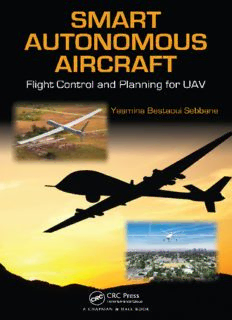
Smart autonomous aircraft : flight control and planning for UAV PDF
Preview Smart autonomous aircraft : flight control and planning for UAV
SMART AUTONOMOUS AIRCRAFT Flight Control and Planning for UAV TThhiiss ppaaggee iinntteennttiioonnaallllyy lleefftt bbllaannkk SMART AUTONOMOUS AIRCRAFT Flight Control and Planning for UAV Yasmina Bestaoui Sebbane Université d’Evry, France CRC Press Taylor & Francis Group 6000 Broken Sound Parkway NW, Suite 300 Boca Raton, FL 33487-2742 © 2016 by Taylor & Francis Group, LLC CRC Press is an imprint of Taylor & Francis Group, an Informa business No claim to original U.S. Government works Version Date: 20151012 International Standard Book Number-13: 978-1-4822-9916-8 (eBook - PDF) This book contains information obtained from authentic and highly regarded sources. Reasonable efforts have been made to publish reliable data and information, but the author and publisher cannot assume responsibility for the validity of all materials or the consequences of their use. The authors and publishers have attempted to trace the copyright holders of all material reproduced in this publication and apologize to copyright holders if permission to publish in this form has not been obtained. If any copyright material has not been acknowledged please write and let us know so we may rectify in any future reprint. Except as permitted under U.S. Copyright Law, no part of this book may be reprinted, reproduced, transmitted, or utilized in any form by any electronic, mechanical, or other means, now known or hereafter invented, including photocopying, microfilming, and recording, or in any information stor- age or retrieval system, without written permission from the publishers. For permission to photocopy or use material electronically from this work, please access www.copy- right.com (http://www.copyright.com/) or contact the Copyright Clearance Center, Inc. (CCC), 222 Rosewood Drive, Danvers, MA 01923, 978-750-8400. CCC is a not-for-profit organization that pro- vides licenses and registration for a variety of users. For organizations that have been granted a photo- copy license by the CCC, a separate system of payment has been arranged. Trademark Notice: Product or corporate names may be trademarks or registered trademarks, and are used only for identification and explanation without intent to infringe. Visit the Taylor & Francis Web site at http://www.taylorandfrancis.com and the CRC Press Web site at http://www.crcpress.com Dedication To my family TThhiiss ppaaggee iinntteennttiioonnaallllyy lleefftt bbllaannkk Contents Preface.........................................................................................................xv Author.......................................................................................................xvii Chapter 1 Introduction...........................................................................1 1.1 Current UAV Presentation.............................................1 1.2 Autonomous Aircraft.....................................................4 1.3 Smart Autonomous Aircraft..........................................9 1.4 Outline of the Book.....................................................11 Chapter 2 Modeling..............................................................................19 2.1 Introduction.................................................................19 2.2 Reference Frames and Coordinate Systems..................20 2.2.1 Inertial Frame...................................................21 2.2.2 Earth-Centered Reference Frame......................21 2.2.2.1 Geocentric-inertial frame...................21 2.2.2.2 Earth frame.......................................21 2.2.3 Geographic Frame............................................21 2.2.3.1 Navigation frame...............................21 2.2.3.2 Tangent plane frame..........................22 2.2.4 Body Frame......................................................22 2.2.5 Wind Frame......................................................24 2.2.6 Special Euclidean Group..................................25 2.3 Kinematic Models........................................................26 2.3.1 Translational Kinematics..................................27 2.3.2 Six Degrees of Freedom Formulation................27 2.3.3 Special Euclidean Space...................................28 2.3.4 Curvature and Torsion.....................................28 2.4 Dynamic Models..........................................................29 2.4.1 Aerodynamics Forces and Moments.................30 2.4.1.1 Negligible side-slip angle....................32 2.4.1.2 Nonnegligible side-slip angle..............33 2.4.2 Translational Dynamics: Coordinated Flight....34 2.4.2.1 Aircraft at constant altitude..............38 2.4.2.2 Aircraft in a vertical flight.................39 2.4.3 Translational Dynamics: Noncoordinated Flight................................................................39 vii viii Contents 2.4.4 Six Degrees of Freedom Dynamics....................40 2.4.4.1 General formulation...........................40 2.4.4.2 Poincar´eformulation..........................42 2.4.4.3 Longitudinal model............................42 2.4.4.4 Lateral model.....................................43 2.4.5 Uncertainty.......................................................44 2.5 Multi-Model Approach.................................................48 2.5.1 Global Representation from Local Models.......48 2.5.2 Linear Approximate Model...............................49 2.5.2.1 Linear longitudinal model..................50 2.5.2.2 Linear lateral model...........................51 2.5.2.3 Linear translational model.................51 2.5.3 Linear Parameter Varying Model: Takagi– Sugeno Formulation..........................................53 2.5.3.1 Longitudinal model............................56 2.5.3.2 Lateral model.....................................57 2.5.3.3 Multi-modelapproachfortracking error model for an aircraft at con- stant altitude.....................................59 2.5.3.4 Multi-modelapproachfortracking error model for a 3D aircraft.............61 2.5.4 Fuzzy Modeling................................................66 2.5.4.1 Type 1 Mamdani approach................66 2.5.4.2 FuzzyestimationofTakagi–Sugeno models................................................68 2.5.4.3 Type 2 fuzzy systems.........................70 2.5.5 Linear Hybrid Automaton................................74 2.5.5.1 Stochastic linear hybrid system.........75 2.5.5.2 State transition..................................76 2.5.5.3 Specific fuel consumption...................77 2.6 Mission Tools...............................................................77 2.6.1 Sensors..............................................................78 2.6.2 Camera Model..................................................81 2.6.3 Software............................................................82 2.6.3.1 Petri nets...........................................84 2.6.3.2 Middleware........................................84 2.6.4 Human Supervisory Modeling..........................85 2.6.4.1 Operator modeling.............................86 2.6.4.2 Retrial queuing model.......................87 2.7 Atmosphere..................................................................88 2.7.1 Gusts and Wind Shear.....................................90 2.7.2 Turbulence........................................................92 2.8 Conclusion....................................................................95 Contents ix Chapter 3 Flight Control....................................................................103 3.1 Introduction...............................................................103 3.2 Linear Control Methods.............................................105 3.2.1 Properties of Linear Systems..........................105 3.2.1.1 Controllability and observability......105 3.2.1.2 Stability of a linear system..............106 3.2.2 Linear Approaches for LTI Models.................108 3.2.2.1 PID control......................................109 3.2.2.2 Classical methods............................109 3.2.2.3 Adaptive approach...........................111 3.2.2.4 Robust control method for LTI models..............................................114 3.2.3 Gain Scheduling..............................................117 3.2.4 Receding Horizon Approach for LTV Models............................................................118 3.2.5 Linear Parameter Varying Models..................119 3.2.5.1 Principle..........................................120 3.2.5.2 Paralleldistributed compensator.....122 3.2.5.3 Integral action..................................124 3.2.5.4 Gain scheduling...............................126 3.2.5.5 Cost control analysis: Actuator saturation.........................................129 3.3 Nonlinear Control......................................................131 3.3.1 Affine Formulation of Aircraft Models............131 3.3.1.1 Affine formulation without drift......135 3.3.1.2 Affine formulation with drift............136 3.3.1.3 Properties........................................139 3.3.1.4 Decoupling by feedback linearization.....................................140 3.3.2 Input/Output Linearization...........................142 3.3.3 Dynamic Inversion..........................................143 3.3.4 Control Lyapunov Function Approach...........145 3.3.4.1 Properties........................................146 3.3.4.2 Trajectory tracking..........................147 3.3.4.3 Path tracking...................................149 3.3.4.4 Circular path following in wind with input constraints......................151 3.3.4.5 Tracking of moving targets with wind term........................................153 3.3.4.6 Suboptimal control..........................155 3.3.4.7 Measurement error input to state stability............................................161 3.3.4.8 Control Lyapunov function based adaptive control...............................163
